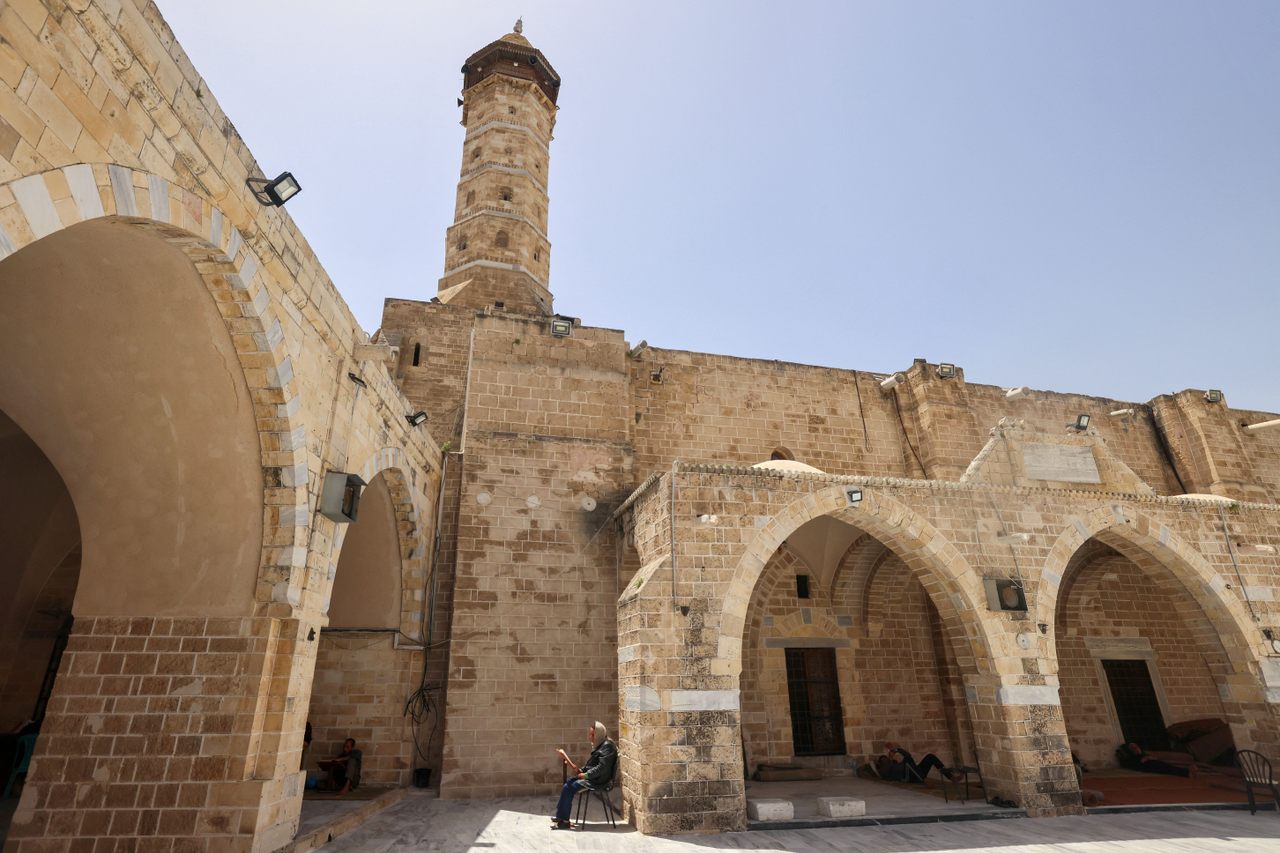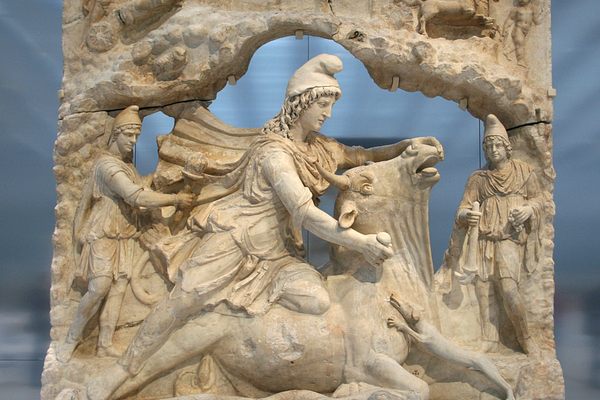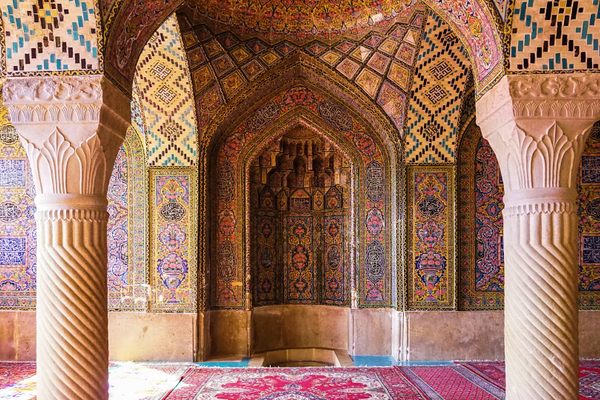The Site of Gaza’s Oldest Mosque Has a Rich, Millennia-Old History
The seventh-century Omari Mosque, severely damaged in a recent airstrike, included artifacts of Roman gods, Jewish rituals, and Byzantine and Catholic churches.
This story was originally published on The Conversation. It appears here under a Creative Commons license.
The Omari Mosque in Gaza was largely destroyed by Israeli bombardment on Dec. 8, 2023. It was one of the most ancient mosques in the region and a beloved Gazan landmark.
The mosque was first built in the early seventh century and named after Islam’s second caliph, Umar ibn al-Khattab, a successor to the Prophet Muhammad and leader of the early Islamic community. It was a graceful white stone structure, with repeating vistas of pointed arches and a tall octagonal minaret encircled by a carved wooden balcony and crowned with a crescent.
The lower half of the minaret and a few exterior walls are reported to be the only parts of the mosque still standing.
Gaza is rich in cultural treasures, with some 325 formally registered heritage sites within just 141 square miles, including three designated for UNESCO’s World Heritage tentative list. The Omari Mosque is one of over 200 ancient sites damaged or destroyed in Israeli raids since the Oct. 7, 2023, Hamas attack.
As a scholar of Islamic architecture and archaeology, I know the Omari Mosque as a building that embodies the history of Gaza itself—as a site of frequent destruction, but also of resilience and renewal. While narratives about Gaza often center on war and conflict, Gaza’s rich history and pluralistic identity as expressed through its cultural heritage equally deserve to be known.

The sun-soaked coastal enclave of Gaza, with the tidy stone buildings of its old city and its verdant olive and orange groves, has been a trade hub that connected the Mediterranean with Africa, Asia, and Europe for millennia. It was famed in particular as a transit point for incense, one of the ancient world’s most precious commodities. Given its abundant agricultural and maritime riches, Gaza has known conquest by nearly every powerful empire, including the ancient Egyptians, the Romans, the early Islamic caliphs, the Crusaders, and the Mongols.
Gaza’s history of repeated conquest meant that buildings were often destroyed, reimagined, and rededicated to accommodate changing political and religious practices. New sacred structures were continually built over old ones, and they frequently incorporated spolia, or stones reused from prior buildings. The Omari Mosque, too, was such an architectural palimpsest: a building embodying the layered, living material history of the city.
In the second millennium B.C., the site of the mosque is believed to have been a temple for Dagon, the Philistine god of the land and good fortune. The temple is mentioned in the Hebrew Bible as the one whose walls were felled by the warrior Samson, who is locally believed to be buried in its foundations.
In 323 B.C., Gaza fiercely resisted the conquest of Alexander the Great, and the city endured devastating destruction when it was finally subdued. Yet after Gaza was conquered by the Romans in 50 B.C. it entered a period of renewed wealth and prosperity. A concentric domed temple was built for Marnas, a god of storms and the protector of the city, on the site of the future mosque. He was venerated there until just before the year 400, when the Byzantine Empress Eudoxia imposed the new faith of Christianity and ordered the destruction of the temple.

The priests of the temple barricaded themselves inside and hid the statues and ritual objects in an underground room. But the temple was destroyed and a Greek Orthodox church rose in its place. The stones, however, preserved the tale: In 1879 a monumental, 10-foot-high statue of Marnas, portrayed in the guise of Zeus, was excavated; its discovery made international media headlines. The statue is now in the Istanbul Archaeological Museums.
The Byzantine church, too, was destined to be transformed. In the early seventh century, the Muslim general Amr ibn al-As conquered Gaza, and the church was converted into the Omari Mosque. Yet the continued presence of Gazan churches and synagogues attested to pluralistic norms that characterized the region under various Islamic dynasties until the modern era.
Gaza thrived under Islamic rule: Medieval travelers described it as a remarkably fertile, creative, and beautiful city, with prominent Muslim, Christian, and Jewish communities. It was still a flourishing urban center when the European Crusaders arrived. When the city fell to the Crusader King of Jerusalem, Baldwin III, in 1100, the Omari Mosque was converted once again—this time into a Catholic cathedral dedicated to St. John the Baptist.
The Muslim general Saladin defeated the Crusaders in 1187, and Gaza returned to Islamic rule. The church was transformed back into a mosque, and in the 13th century its elegant octagonal minaret was raised. Yet the reconversion into a mosque preserved much of the Crusader church, and the majority of the nave and the western portal were still visible in modern times.
It was in this period that the mosque became famed for its extraordinary library containing thousands of books, the earliest dating to the 13th century. After the library of the Al-Aqsa Mosque in Jerusalem, the Omari Mosque’s collection was one of the richest in Palestine.
In the 13th century, the mosque endured destruction by the Mongols as well as major earthquakes that would repeatedly topple the minaret. Its rebuilding after each of these disasters speaks to the ongoing centrality of the mosque in the communal life of the people of Gaza.
Later, Gaza continued to flourish as a coastal port city, where Muslims, Christians, Jews and others lived in the vast, cosmopolitan Ottoman Empire.
In the late 19th century, as scholars explored Gaza’s heritage, an eloquent reminder of the building’s layered history emerged: a relief on a mosque pillar depicting a seven-branched menorah and Jewish ritual objects, including a shofar, or horn, surrounded by a wreath. The name Hanania, son of Jacob, was engraved in Hebrew and Greek.
Its date is uncertain, but it seems likely to have been a column from a synagogue reused during the building of the Byzantine church, which was used again in the building of the mosque: yet another layer in the architectural palimpsest that was the Omari Mosque.

A few decades later, during World War I, the mosque was severely damaged when a nearby Ottoman arms depot was targeted by British artillery fire. In the 1920s, the stones were once again gathered and the mosque was rebuilt.
After the 1948 creation of the state of Israel, Gaza became the sanctuary of tens of thousands of Palestinian refugees. The area was primarily administered by Egypt until it was captured by Israel in 1967. It was at some point after the 1967 war, when Jewish symbols had come to be associated with the state of Israel and its occupation of Gaza, that the menorah relief was effaced from the column in the mosque.
On Dec. 8, 2023, Israel became the most recent military force to target the mosque. The library, too, may have been ruined, a treasure house of knowledge that will not so easily be rebuilt. A digitization project completed in 2022 preserves an imprint of the library’s riches. Still, digital files can’t replace the material significance of the original manuscripts.
The hundreds of other heritage sites damaged or destroyed include Gaza’s ancient harbor and the fifth-century Greek Orthodox Church of Saint Porphyrius, one of the oldest churches in the world.
From today’s vantage point, it seems extraordinary that the menorah relief had endured for over 1,000 years: a Jewish symbol unremarkably cohabiting inside a Muslim prayer hall. In truth, both the relief and its removal embody the story of Gaza itself, a fitting reminder of the many centuries of destruction, coexistence, and resilience embodied in the mosque’s very stones.
And if the Omari Mosque’s richly layered history is any indication, the people of Gaza will raise those stones again.
Stephennie Mulder is an associate professor of art history, at The University of Texas at Austin.




































Follow us on Twitter to get the latest on the world's hidden wonders.
Like us on Facebook to get the latest on the world's hidden wonders.
Follow us on Twitter Like us on Facebook